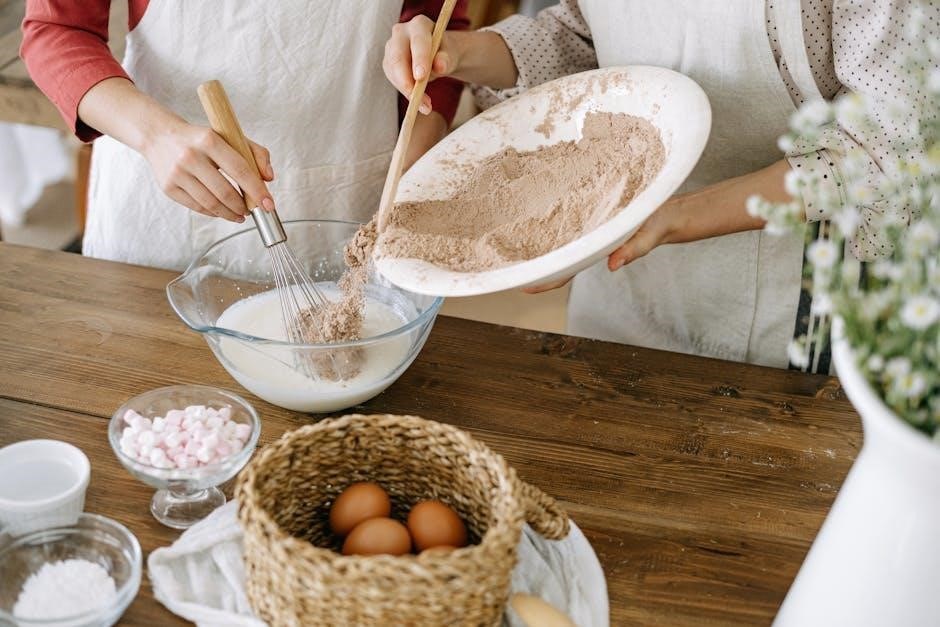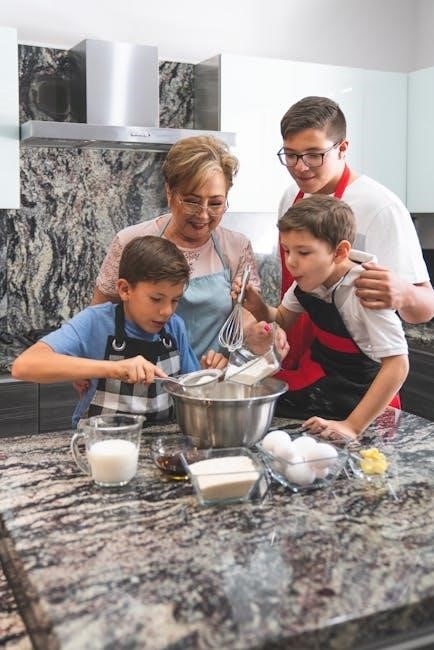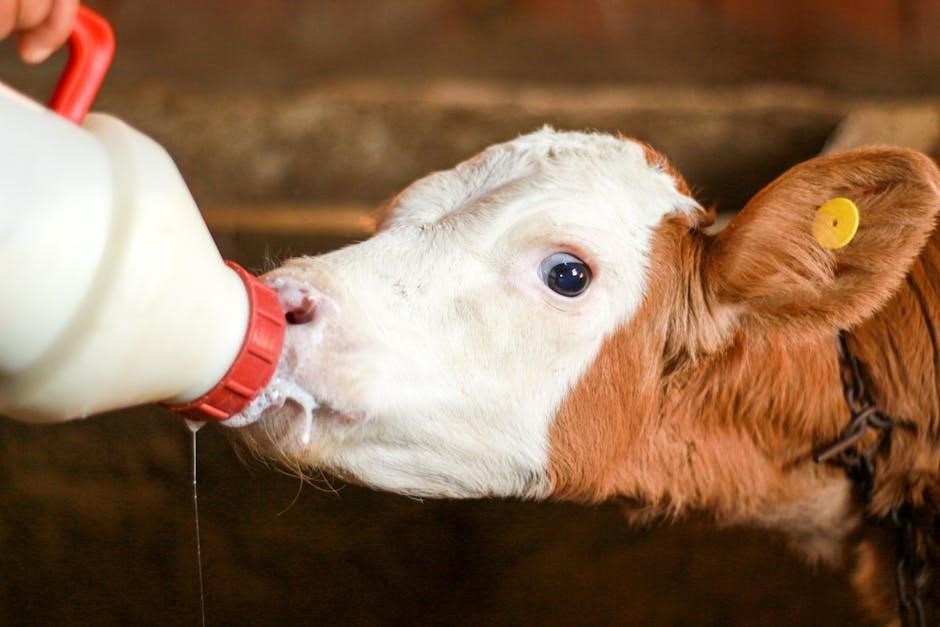Properly mixing Purina Calf Milk Replacer ensures optimal nutrition and health for calves. This guide provides step-by-step instructions for accurate measurement, water temperature, and thorough mixing to achieve the perfect consistency every time, adhering to manufacturer guidelines for best results.
Overview of Purina Calf Milk Replacer
Purina Calf Milk Replacer is a nutritionally balanced formula designed to support healthy growth and development in calves. It typically contains 24% protein and 20% fat, providing essential nutrients for optimal performance. The replacer is easy to mix and is often medicated to promote health. It’s formulated to mimic natural milk, making it an excellent alternative for feeding calves. Proper mixing ensures calves receive consistent nutrition, supporting their overall well-being and growth potential.
Importance of Proper Mixing Techniques
Proper mixing of Purina Calf Milk Replacer is crucial for calf health and performance. Incorrect mixing can lead to inconsistent nutrient delivery, affecting growth rates and potentially causing digestive issues. Ensuring the powder fully dissolves in water at the right temperature prevents clumping and maintains the solution’s nutritional integrity. Accurate measurement and thorough mixing also help avoid under- or over-feeding, supporting optimal calf development and minimizing health risks associated with improper nutrition.
Materials Needed for Mixing
To mix Purina Calf Milk Replacer, you’ll need a clean container, a bucket, a calibrated scale, the powder, and water. These materials ensure proper mixing and safety.
Equipment Requirements
To mix Purina Calf Milk Replacer effectively, you’ll need a clean, sturdy container, a bucket, a calibrated scale for accurate powder measurement, and a whisk or spoon for thorough mixing. A measuring cup or scoop is also essential for precise portion control. Ensure the container is large enough to hold the total volume of mixed milk replacer without spilling. Using the right equipment helps prevent contamination and ensures the powder dissolves properly for a smooth, consistent mix every time.
Water Quality Guidelines
Use clean, low-sodium water (<50 ppm) for mixing Purina Calf Milk Replacer to ensure optimal hydration and nutrient absorption. Avoid water with high levels of minerals, bacteria, or contaminants, as these can harm calves or affect the mix’s consistency. Water should be fresh and free from any strong odors or impurities. For best results, use water at a temperature of 110°F to 120°F when mixing to dissolve the powder effectively and maintain a safe feeding temperature for calves.

Step-by-Step Mixing Instructions
Measure the powder accurately, add it to half the water, mix thoroughly, then add the remaining water, and check the temperature before feeding to ensure safety and effectiveness.
Measuring the Powder
Accurate measurement of Purina Calf Milk Replacer powder is crucial for proper mixing. Use a calibrated scale to weigh the powder, ensuring consistency and nutrition. For most formulations, 1.5 lbs of powder is mixed with 1 gallon of water. Avoid using cups or scoops, as they may lead to inconsistent measurements. Precise weighing ensures the correct nutrient concentration, promoting healthy calf growth and development. Always follow the manufacturer’s recommended ratio for optimal results and proper mixing techniques.
Adding Powder to Water
Begin by filling a clean container with half the total volume of water needed. Add the measured Purina Calf Milk Replacer powder slowly while stirring with a whisk or paddle. Ensure the powder dissolves completely to avoid clumps. Continue mixing until the solution is smooth and even. Gradually add the remaining water, stirring thoroughly to maintain consistency. Avoid over-mixing, as it may create excessive foam. Proper dissolution ensures the milk replacer is ready for feeding at the optimal temperature.
Final Adjustments and Temperature Check
Once mixed, use a thermometer to ensure the solution reaches 102-107°F (39-42°C). Stir gently to achieve an even consistency. If needed, add small amounts of water to adjust thickness. Ensure no clumps remain and the mixture is smooth. Avoid overheating, as it may harm the calf. Use low-sodium water (<50 ppm) for mixing to prevent health issues. Double-check the temperature before feeding to ensure it’s safe for the calf to consume. Proper temperature and consistency are crucial for digestion and growth. Mix should be fed immediately to prevent cooling below optimal levels, which can reduce effectiveness.

Feeding Temperature and Best Practices
Feed at 102-107°F (39-42°C) for optimal calf health. Ensure the solution is warm but not hot, adhering to manufacturer guidelines for temperature and portion control.
Optimal Feeding Temperature
The ideal feeding temperature for Purina Calf Milk Replacer is between 102°F and 107°F (39°C to 42°C). This range ensures the milk replacer is warm enough to mimic natural cow’s milk while preventing digestive discomfort. Feeding at this temperature promotes proper digestion and nutrient absorption, which are critical for calf health and growth. Avoid feeding too hot or too cold, as it may lead to health issues or reduced intake. Always check the temperature before offering it to the calves to ensure their comfort and safety.
Feeding Schedule and Portion Control
Calves should be fed 2 to 2.3 quarts of Purina Calf Milk Replacer per feeding, divided into 2-3 feedings daily. Newborns require 4 quarts of high-quality colostrum initially, transitioning to milk replacer. Portion control is crucial to ensure proper growth and digestion. Overfeeding can lead to health issues, while underfeeding may stunt development. Adjust portions based on the calf’s age, size, and appetite, following Purina’s guidelines for optimal results and maintaining a consistent feeding schedule for healthy growth.

Storage and Disposal
Store mixed Purina Calf Milk Replacer in the refrigerator to prevent spoilage. Dispose of unused product according to local regulations, ensuring proper waste management practices are followed.
Storing Mixed Milk Replacer
After mixing, store the Purina Calf Milk Replacer in a clean, airtight container to maintain freshness. Keep it refrigerated at 39°F to 45°F (4°C to 7°C) to prevent spoilage. Use the mixed replacer within 24 hours for optimal quality. Avoid freezing, as this can alter the texture and nutritional integrity. Always check the mixture for any signs of spoilage before feeding to calves to ensure their health and safety. Proper storage ensures the milk replacer remains effective and safe for consumption.
Proper Disposal of Unused Product
Dispose of unused Purina Calf Milk Replacer responsibly to prevent environmental contamination. Store unused powder in its original bag or a sealed container to maintain freshness. For mixed replacer, discard any unused portion after 24 hours. Do not pour down drains, as this may harm aquatic life. Instead, dispose of it in a sealed container with the lid tightly closed and follow local waste management guidelines. Clean all utensils and containers thoroughly after use to ensure hygiene and safety.

Common Mistakes to Avoid
Common mistakes include over- or under-mixing, ignoring manufacturer guidelines, and using incorrect water temperatures. These errors can affect calf health and nutrient absorption negatively.
Over- or Under-Mixing
Over-mixing or under-mixing Purina Calf Milk Replacer can lead to inconsistent nutrient distribution, affecting calf health. Over-mixing may cause foaming or uneven texture, while under-mixing leaves powder undissolved. Both scenarios can result in digestive issues or reduced nutrient absorption. Ensure the powder is fully dissolved without over-aeration. Use the recommended water temperature (110-120°F) and mix thoroughly to achieve the correct consistency. Avoiding these common mistakes ensures the milk replacer meets the calf’s nutritional needs effectively.
Ignoring Manufacturer Guidelines
Ignoring Purina’s instructions can lead to improper mixing, affecting calf health and growth. Using incorrect water temperatures or ratios may result in digestive issues or poor nutrient absorption. Manufacturer guidelines ensure optimal consistency and nutrient delivery. Deviating from recommended practices can compromise the product’s effectiveness and the calf’s well-being. Always adhere to the specified mixing ratios, water temperatures, and feeding schedules to maximize the benefits of Purina Calf Milk Replacer and support healthy calf development.
Troubleshooting Mixing Issues
Common mixing issues include clumping, incorrect consistency, or uneven dissolution. Check water temperature, powder measurement, and mixing technique to resolve problems quickly and ensure proper preparation.
Clumping or Undissolved Powder
Clumping or undissolved powder can occur if water is too cold or powder is added too quickly. To fix, ensure water is 110-120°F, add powder gradually, and mix thoroughly. Using a whisk or agitation improves dissolution. Avoid overfilling containers, as this hinders proper mixing. If clumps form, stir vigorously or reheat slightly. Proper temperature and gradual addition prevent these issues, ensuring a smooth, consistent mixture for optimal calf nutrition.
Incorrect Consistency or Temperature
Incorrect consistency or temperature can lead to poor digestion or reduced nutrient absorption. If the mixture is too thick, it may cause dehydration, while being too thin dilutes essential nutrients. Ensure water temperature is between 110°F and 120°F for proper powder dissolution. Avoid overheating, as it can damage nutrients. Adjust consistency by adding small amounts of water or powder as needed. Always aim for a smooth, even texture and a final feeding temperature of 102°F to 107°F for optimal calf health and performance.
Proper mixing of Purina Calf Milk Replacer ensures optimal nutrition for calves, promoting healthy growth and development. Always follow guidelines for best results and calf well-being.
Key Takeaways for Successful Mixing
Accurate measurement using a scale is crucial for consistent results. Use water at 110-120°F for proper dissolving. Mix thoroughly to avoid clumps and ensure even distribution. Avoid over- or under-mixing, as this can affect nutrient balance. Always check the final temperature (around 104°F) for safe feeding. Adhere strictly to manufacturer guidelines for optimal calf health and performance. Proper mixing ensures the replacer meets nutritional needs, supporting healthy growth and development in calves.
Manufacturers’ Final Recommendations
Always follow the manufacturer’s guidelines for precise mixing ratios and temperatures; Use a calibrated scale to measure powder accurately. Ensure water quality is high, with low sodium levels (<50 ppm). Mix thoroughly to prevent clumps and achieve the correct consistency. Feed at the recommended temperature (around 104°F). Avoid over- or under-mixing, as this can harm calf health. Store mixed replacer properly and dispose of unused product safely. Start calves on starter feed once they consistently consume 1 kg for three days to ease weaning.